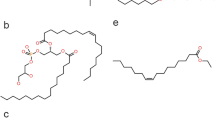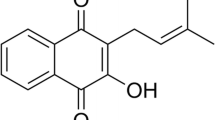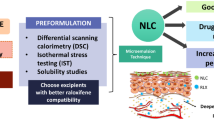Abstract
The purpose of this work was to develop w/o emulsions that could be safely used to promote transdermal delivery of 5-fluorouracil (5-FU). Two pseudo-ternary phase diagrams comprising oleoyl-macrogol glycerides, water, and a surfactant/co-surfactant (S/CoS) mixture of lecithin, ethanol, and either coco glucoside or decyl glucoside were investigated for their potential to develop promising 5-FU emulsions. Six systems were selected and subjected to thermodynamic stability tests; heat–cool cycles, centrifugation, and finally freeze–thaw cycles. All systems passed the challenges and were characterized for transmission electron microscopy, droplet size, rheological behavior, pH, and transdermal permeation through newly born mice skin in Franz diffusion cells. The systems had spherical droplets ranging in diameter from 1.81 to 2.97 μm, pH values ranging from 7.50 to 8.49 and possessed Newtonian flow. A significant (P < 0.05) increase in 5-FU permeability parameters as steady-state flux, permeability coefficient was achieved with formula B5 comprising water (5% w/w), S/CoS mixture of lecithin/ethanol/decyl glucoside (14.67:12.15:18.18% w/w, respectively) and oleoyl-macrogol glycerides (50% w/w). When applied to shaved rat skin, this system was well tolerated with only moderate skin irritation that was recovered within 12 h. Indeed, minor histopathologic changes were observed after 5-day treatment. Further studies should be carried out, in the future, to investigate the potentiality of this promising system to promote transdermal delivery of 5-FU through human skin.






Similar content being viewed by others
REFERENCES
University of Sciences of Philadelphia (ed): Remington: The science and practice of pharmacy, 21st edn. Lippincott Williams & Wilkins, Philadelphia (2005).
Saif MW, Choma A, Salamone SJ, Chu E. Pharmacokinetically guided dose adjustment of 5-fluorouracil: a rational approach to improving therapeutic outcomes. J Natl Cancer Inst. 2009;101(22):1543–52.
Sweetman S. Martindale: The complete drug reference. 34th ed. London: The Pharmaceutical Press; 2005. Electronic version.
Diasio RB, Harris BE. Clinical pharmacology of 5-fluorouracil. Clin Pharmacokinet. 1989;16(4):215–37.
Liu F, Xiao YY, Ping QN, Yang C. Water in oil microemulsions for transdermal delivery of fluorouracil. Yao Xue Xue Bao. 2009;44(5):540–7.
Gupta RR, Jain SK, Varshney M. AOT water-in-oil microemulsions as a penetration enhancer in transdermal drug delivery of 5-fluorouracil. Colloids Surf, B. 2005;41:25–32.
Robertsand WJ, Sloan KB. Topical delivery of 5-fluorouracil (5-FU) by 3-alkylcarbonyloxymethyl-5-FU prodrugs. J Pharm Sci. 2003;92:1028–36.
Beall HD, Sloan KB. Topical delivery of 5-fluorouracil (5-FU) by 1, 3-bisalkylcarbonyl-5-FU prodrugs. Int J Pharm. 2002;231(1):43–9.
Sasaki H, Kojima M, Mori Y, Nakamura J, Shibasaki J. Enhancing effect of pyrrolidone derivatives on transdermal penetration of 5-fluorouracil, triamcinolone acetonide, indomethacin, and flurbiprofen. J Pharm Sci. 1991;80(6):533–8.
Goodman M, Barry BW. Action of penetration enhancers on human skin as assessed by the permeation of model drugs 5-fluorouracil and estradiol. I. Infinite dose technique. J Invest Dermatol. 1988;91(4):323–7.
Trotta M, Ugazio E, Peira E, Pulitano C. Influence of ion pairing on topical delivery of retinoic acid from microemulsions. J Control Release. 2003;86:315–21.
Rybinski WV, Hill K. Alkyl polyglycosides-properties and applications of a new class of surfactants. Angew Chem Int. 1998;37:1328–45.
Garcia MT, Ribosa L, Campos E, Leal JS. Ecological properties of alkyl glucosides. Chemosphere. 1997;35:545–56.
Pezroni I, Galet L, Clausse D. Surface interaction between a protein monolayer and surfactants and its correlation with skin irritation by surfactants. J Colloid Interface Sci. 1996;180:285–9.
Mehling A, Kleber M, Henson H. Comparative studies on the ocular and dermal irritation potential of surfactants. Food Chem Toxicol. 2005;45:747–58.
Savic SD, Savic MM, Tamburic S, Vesic SA, Vuleta GM, Müller-Goymann CC. An alkyl polyglucoside surfactant as a prospective pharmaceutical excipient for topical formulations: the influence of oil polarity on the colloidal structure and hydrocortisone in vitro/in vivo permeation. Eur J Pharm Sci. 2007;30:441–50.
Pakpayat N, Nielloud FR, Fortuné C, Peteilh T, Villarreal A, Grillo I, et al. Formulation of ascorbic acid microemulsions with alkyl polyglycosides. Eur J Pharm Biopharm. 2009;72:444–52.
Graf A, Ablinger E, Peters S, Zimmer A, Hook S, Rades T. Microemulsions containing lecithin and sugar-based surfactants: Nano-particle templates for delivery of proteins and peptides. Int J Pharm. 2008;350:351–60.
Rybinski WV, Guchkenbiehl B, Tesmann H. Influence of co-surfactants on microemulsions with alkyl polyglycosides. Colloids Surf A. 1998;142:333–42.
Jadhav KR, Kadam VJ, Pisal SS. Formulation and evaluation of lecithin organogel for topical delivery of fluconazole. Curr Drug Deliv. 2009;6(2):174–83.
Yuan JS, Ansari M, Samaan M, Acosta EJ. Linker-based lecithin microemulsions for transdermal delivery of lidocaine. Int J Pharm. 2008;349(1–2):130–43.
Tabbakhian M, Tavakoli N, Jaafari MR, Daneshamouz S. Enhancement of follicular delivery of finasteride by liposomes and niosomes 1. In vitro permeation and in vivo deposition studies using hamster flank and ear models. Int J Pharm. 2006;323(1–2):1–10.
Bendas ER, Tadros MI. Enhanced transdermal delivery of salbutamol sulfate via ethosomes. AAPS PharmSciTech. 2007;8(4):107.
Shafiq S, Shakeel F, Talegaonkar S, Ahmad FJ, Khar RK, Ali M. Development and bioavailability assessment of ramipril nanoemulsion formulation. Eur J Pharm Biopharm. 2007;66(2):227–34.
Chew NYK, Chan HK. Effect of powder polydispersity on aerosol generation. J Pharm Sci. 2002;5(2):162–8.
Rawlins EA. Rheology. In: Carless JE, editor. Bentley’s textbook of pharmaceutics. 8th ed. London: Bailliére Tindall; 1977. p. 123–39.
Das MK, Bhattacharya A, Ghosal SK. Effect of different terpene-containing essential oils on percutaneous absorption of trazodone hydrochloride through mouse epidermis. Drug Deliv. 2006;3:425–31.
El Maghraby GM, Williams AC, Barry BW. Skin delivery of estradiol from deformable and traditional liposomes: mechanistic studies. J Pharm Pharmacol. 1999;51:1123–34.
Ferreira LAM, Seiller M, Grossiord JL, Marty JP, Wepierre J. Vehicle influence on in vitro release of glucose: w/o, w/o/w and o/w systems compared. J Control Release. 1995;33:349–56.
Shakeel F, Baboota S, Ahuja A, Ali J, Aqil M, Shafiq S. Nanoemulsions as vehicles for transdermal delivery of aceclofenac. AAPS PharmSciTech. 2007;8(4):104.
Jibry N, Murdan S. In vivo investigation, in mice and in man, into the irritation potential of novel amphiphilogels being studied as transdermal drug carriers. Eur J Pharm Biopharm. 2004;58:107–19.
Draize J, Woodard G, Calvery H. Methods for the study of irritation and toxicity of substances topically applied to skin and mucous membranes. J Pharmacol Exp Ther. 1944;82:377–90.
Banchroft JD, Stevens A, Turner DR. Theory and practice of histological techniques. 4th ed. New York: Churchil Livingstone; 1996.
Lawrence MJ, Rees GD. Microemulsion-based media as novel drug delivery systems. Adv Drug Deliv Rev. 1995;45:89–121.
Tenjarla S. Microemulsions: an overview and pharmaceutical applications. Crit Rev Ther Drug Carrier Syst. 1999;16:461–521.
Kriwet K, Miiller-Goymann CC. Diclofenac release from phospholipid drug systems and permeation through excised human stratum corneum. Int J Pharm. 1995;125:231–42.
Stubenrauch C, Paeplow B, Findenegg GH. Microemulsions supported by Octyl monoglucoside and geraniol. 1. The role of the alcohol in the interfacial layer. Langmuir. 1997;13(14):3652–8.
Azeem A, Khan ZI, Aqil M, Ahmad FJ, Khar RK, Talegaonkar S. Microemulsions as a surrogate carrier for dermal drug delivery. Drug Dev Ind Pharm. 2009;35(5):525–47.
Subramanian N, Ghosal SK, Acharya A, Moulik SP. Formulation and physicochemical characterization of microemulsion system using isopropyl myristate, medium-chain glyceride, polysorbate 80 and water. Chem Pharm Bull. 2005;53(12):1530–5.
Ammar HO, Salama HA, Ghorab M, Mahmoud AA. Nanoemulsion as a potential ophthalmic delivery system for dorzolamide hydrochloride. AAPS PharmSciTech. 2009;10(3):808–19.
Rhee YS, Choi JG, Park ES, Chi SC. Transdermal delivery of ketoprofen using microemulsions. Int J Pharm. 2001;228:161–70.
Walters KA, Brain KR, Green DM, James VG, Watkinson AC, Sands RH. Comparison of the transdermal delivery of estradiol from two gel formulations. Maturitas. 1998;29:189–95.
Lee CH, Maibach HI. The sodium lauryl sulphate model: an overview. Contact Dermat. 1995;33:1–7.
Feldman LD, Ajani JA. Fluorouracil-associated dermatitis of the hands and feet. JAMA. 1985;254(24):3479–85.
ACKNOWLEDGEMENTS
The authors would like to thank Dr. Adel Bakir (Prof. of Pathology, Cairo University, Egypt) for his kind help in preparation and histopathologic examination of rat skin biopsies.
Author information
Authors and Affiliations
Corresponding author
Rights and permissions
About this article
Cite this article
ElMeshad, A.N., Tadros, M.I. Transdermal Delivery of an Anti-Cancer Drug via W/O Emulsions Based on Alkyl Polyglycosides and Lecithin: Design, Characterization, and In Vivo Evaluation of the Possible Irritation Potential in Rats. AAPS PharmSciTech 12, 1–9 (2011). https://doi.org/10.1208/s12249-010-9557-y
Received:
Accepted:
Published:
Issue Date:
DOI: https://doi.org/10.1208/s12249-010-9557-y




